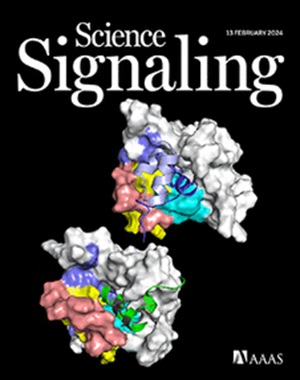初级感觉神经元中的Gαq信号将阿片镇痛转变为NMDA受体驱动的耐受和痛觉过敏
IF 6.6
1区 生物学
Q1 BIOCHEMISTRY & MOLECULAR BIOLOGY
引用次数: 0
摘要
阿片类药物通过激活μ-阿片受体(MORs)来缓解疼痛,而μ-阿片受体抑制痛觉神经元(痛觉感受器)与脊髓之间的交流。然而,长期使用阿片类药物可能会导致疼痛敏感性增加(痛觉过敏)和镇痛效果降低(耐受性),部分原因是脊髓初级感觉神经元中央末端的nmda型谷氨酸受体(NMDARs)被激活。在这里,我们确定了G蛋白Gαq在这一悖论中的关键作用。大鼠Gαq的药理抑制逆转了吗啡诱导的NMDAR磷酸化、突触运输和感觉神经元末梢活性的增加,并减少了吗啡诱导的脊髓背角神经元的兴奋性伤害性输入。吗啡增强了g - αq与脊髓中代谢性谷氨酸受体5 (mGluR5)二聚体特异性偶联。此外,靶向下调小鼠背根神经节神经元Gαq可使nmdar相关变化正常化,并阻止nmdar介导的MOR激活引发的突触增强。此外,g - αq信号的药理或遗传破坏增强了吗啡的镇痛作用,同时降低了痛觉过敏和耐受性。这些发现表明,Gαq信号通过促进MOR-mGluR5串扰,参与阿片类药物诱导的伤害感受器中枢末端NMDAR亢进。靶向这一途径可能提高阿片类药物疼痛管理的安全性和有效性。本文章由计算机程序翻译,如有差异,请以英文原文为准。

Gαq signaling in primary sensory neurons shifts opioid analgesia to NMDA receptor–driven tolerance and hyperalgesia
Opioids relieve pain by activating μ-opioid receptors (MORs), which inhibit communication between pain-sensing neurons (nociceptors) and the spinal cord. However, prolonged opioid use can paradoxically lead to increased pain sensitivity (hyperalgesia) and reduced analgesic efficacy (tolerance), partly because of the activation of NMDA-type glutamate receptors (NMDARs) at the central terminals of primary sensory neurons in the spinal cord. Here, we identified a critical role for the G protein Gαq in this paradox. Pharmacological inhibition of Gαq in rats reversed morphine-induced increases in NMDAR phosphorylation, synaptic trafficking, and activity at sensory neuron terminals and reduced morphine-induced excitatory nociceptive input to spinal dorsal horn neurons. Morphine enhanced Gαq coupling specifically to metabotropic glutamate receptor 5 (mGluR5) dimers in the spinal cord. Furthermore, targeted knockdown of Gαq in dorsal root ganglion neurons in mice normalized NMDAR-related changes and prevented NMDAR-mediated synaptic potentiation triggered by MOR activation. In addition, either pharmacological or genetic disruption of Gαq signaling enhanced morphine’s analgesic effects while reducing hyperalgesia and tolerance. These findings reveal that Gαq signaling contributes to opioid-induced NMDAR hyperactivity at nociceptor central terminals by promoting MOR-mGluR5 cross-talk. Targeting this pathway may improve the safety and efficacy of opioid-based pain management.
求助全文
通过发布文献求助,成功后即可免费获取论文全文。
去求助
来源期刊

Science Signaling
BIOCHEMISTRY & MOLECULAR BIOLOGY-CELL BIOLOGY
CiteScore
9.50
自引率
0.00%
发文量
148
审稿时长
3-8 weeks
期刊介绍:
"Science Signaling" is a reputable, peer-reviewed journal dedicated to the exploration of cell communication mechanisms, offering a comprehensive view of the intricate processes that govern cellular regulation. This journal, published weekly online by the American Association for the Advancement of Science (AAAS), is a go-to resource for the latest research in cell signaling and its various facets.
The journal's scope encompasses a broad range of topics, including the study of signaling networks, synthetic biology, systems biology, and the application of these findings in drug discovery. It also delves into the computational and modeling aspects of regulatory pathways, providing insights into how cells communicate and respond to their environment.
In addition to publishing full-length articles that report on groundbreaking research, "Science Signaling" also features reviews that synthesize current knowledge in the field, focus articles that highlight specific areas of interest, and editor-written highlights that draw attention to particularly significant studies. This mix of content ensures that the journal serves as a valuable resource for both researchers and professionals looking to stay abreast of the latest advancements in cell communication science.
 求助内容:
求助内容: 应助结果提醒方式:
应助结果提醒方式:


